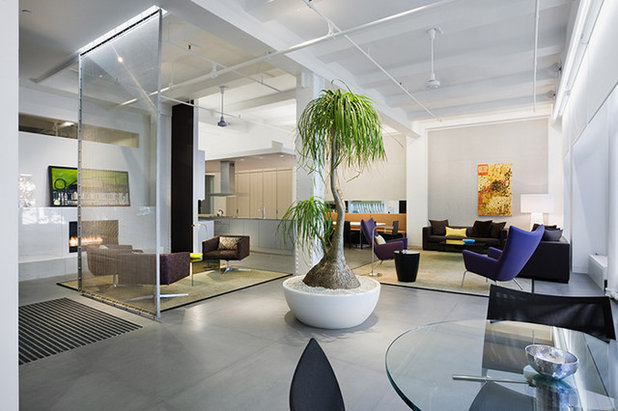Ponytail palm (
Beaucarnea recurvata)
isn't really a palm but rather a member of the agave succulent family. It's a very unusual-looking plant, with a swollen base and a mop of long, flat leaves. Ponytails are easy to care for and drought tolerant, and they make an exotic addition to the home. The only downside is that this houseplant is an extremely slow grower, but that's not such a bad thing for a plant with the nickname elephant's foot.

WXY architecture + urban design
Ponytail palms make excellent container plants and adapt well to air conditioning and heating, which can be detrimental to many houseplants. The large base will require a suitably large pot, and as the plant slowly matures, the trunk will become thicker and the base will swell.
A desert native, it prefers very bright light with some direct sun.

Prestige Builders
The most serious threat to this plant is overwatering or flooding, which can cause root rot and bacterial or fungal diseases. Never allow water to sit in the bottom of the saucer or pot, and when in doubt, don't water. Dry and brown lower foliage, a shriveled stem and desiccated roots are usually signs of underwatering.

Vuong Interior Design
Potted ponytails can be used outdoors but can get damaged in high winds. In areas prone to frost, ponytails are best kept indoors in a container and moved outdoors only after the last freeze.
Pests and diseases. Ponytails are very resistant to pests and disease, though plants in containers indoors are generally susceptible to spider mites, mealybugs and scale. Symptoms range from mottled yellow discoloration on the undersides of leaves to a sticky honeydew substance and yellowed leaves, as well as visibly raised spots. Remedies include washing the leaves or using an insecticidal soap or plant oil extract. If spider mites occur on the leaves, rub a cloth saturated with soap and water on the leaves.

Prestige Builders
When grown outdoors, ponytails can reach 16 feet or more. As indoor potted plants, they tend to average 6 to 8 feet.

MR.MITCHELL
While a ponytail palm needs bright light, it will be fine with getting bright light about half the time. For example, if you keep your plant in relatively low-light conditions in the winter and provide bright-light conditions in spring and summer, it will be perfectly happy.

Dlux Images
How to care for ponytail palm:Temperature: Normal room temperature is good for most of the year, but ponytail palm prefers cooler temperatures in the winter (50 to 55 degrees Fahrenheit).
Lighting: Provide bright indirect light to full sunshine. Any window space indoors, particularly one facing north, is suitable. For optimum performance full sun is best.
Watering: Moderate to low water. Water thoroughly once every two to three weeks, depending on whether it receives full sun. Keep the soil fairly dry. Water from spring through fall, allowing the soil to dry on the surface before rewatering. During the winter water only very occasionally (possibly only one time the entire winter) to keep the foliage from wilting. Be sure to let the soil become dry to the touch 1 to 2 inches deep before watering again.
Soil: Use a fast-draining soil, such as cactus potting soil. A sandy-mix soil generally minimizes the probability of root rot.
Feeding: Fertilize every month in the growing season, or as infrequently as two to three times per year. Overfertilizing can cause brown tips on the leaves.
Repotting: Because ponytail palm requires dry soil, it is best to let it become root bound before repotting. When repotting is absolutely necessary, use a pot that is only an inch or two wider than the previous pot. Repotting into a large pot results in the plant suddenly getting too much water at once, which can damage growth and health, not to mention cause root rot.
Origin: Mexican desert, Belize and Guatemala. In its native habitat, flowers appear on large older trees in upright clusters in the spring and summer.
Toxicity: Nontoxic.
Caution: The leaves have serrated edges that can be abrasive.





